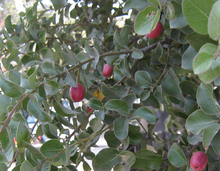| Cryptocarya alba | |
|---|---|

| |
| Scientific classification | |
| Kingdom: | Plantae |
| Clade: | Tracheophytes |
| Clade: | Angiosperms |
| Clade: | Magnoliids |
| Order: | Laurales |
| Family: | Lauraceae |
| Genus: | Cryptocarya |
| Species: | C. alba
|
| Binomial name | |
| Cryptocarya alba | |
Cryptocarya alba, the peumo or Chilean acorn, is an evergreen tree[1] that grows in Chile and Argentina from 33 to 40° southern latitude. It can live both in wet and as in dry conditions. Its distribution can reach up to 1500 meters (5000 ft) above sea level. It measures up to 20 meters (65 ft) height and one meter diameter, with cracked gray bark. An associate tree is the endangered Chilean Wine Palm, Jubaea chilensis,[2] which species prehistorically had a much wider range.
YouTube Encyclopedic
-
1/3Views:5 0981 940380
-
Como Producir Fruta Galupa para Exportación- TvAgro por Juan Gonzalo Angel
-
Capacitación para los Cultivos de Gulupa- TvAgro por Juan Gonzalo Angel
-
Piedras Tacitas en "El Peumo"
Transcription
Description
Leaves are perennial, aromatic, simple, alternate and opposite, 2.5 to 8.5 cm long and one to four cm wide; aovate and entire lobe, a little undulate. The trunk is straight and hardly twisted; brown-grayish cork cambium, relatively smooth, with few cracks and detachable scales when old. Central branches thick and ascending; terminal twigs thin and hanging. The flowers are in dense bunches, greenish yellow and three to four mm long; hermaphrodite, they have six fleshy uneven and hairy petals. It produces edible fruits red-colored, called "peumos", which contain large heavy seeds, which germinate easily.
Cultivation and uses
It has very scented leaves. The fruit is a red berry and is edible. It blooms from November to January (southern hemisphere). The wood is very hard and resistant to moisture. The bark is used for tanning leather and dying orange color. It is appreciated as ornamental and fruit-producing tree. Planted trees in northern California have done very well. Rarely seen in Spain, it has adapted perfectly in that country.
References
- C. Donoso. 2005. Árboles nativos de Chile. Guía de reconocimiento. Edición 4. Marisa Cuneo Ediciones, Valdivia, Chile. 136p.
- Adriana Hoffman. 1998. Flora Silvestre de Chile, Zona Central. Edición 4. Fundación Claudio Gay, Santiago. 254p.
- C. Michael Hogan (2008) Chilean Wine Palm: Jubaea chilensis, GlobalTwitcher.com, ed. N. Stromberg
- R. Rodríguez and M. Quezada. 2001. Laurales. En C. Marticorena and R. Rodríguez [eds.], Flora de Chile Vol. 2, pp 10–19. Universidad de Concepción, Concepción.
Line notes
External links
- "Cryptocarya alba". Encyclopedia of Chilean Flora. Retrieved 2009-06-27.
- "Cryptocarya alba". Chilebosque. Retrieved 2009-06-27.
- "Cryptocarya alba in the city of Fremont, California". Fremontica.
- "Cryptocarya alba in Barcelona, Catalonya, Spain". Jardí Botànic de Barcelona. Archived from the original on June 7, 2009. Retrieved 2009-06-27.
